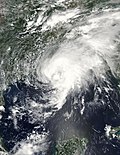Wikipedia:Today's featured article/June 29, 2017
Tropical Storm Bill hit the Gulf Coast of the United States in the summer of 2003. The second storm of that Atlantic hurricane season, Bill developed from a tropical wave on June 29 to the north of the Yucatán Peninsula. It slowly organized as it moved northward, and reached a peak of 60 mph (95 km/h) shortly before making landfall in south-central Louisiana. It produced a moderate storm surge, causing tidal flooding. In Montegut in the southeastern portion of the state, a levee was breached, flooding many homes, and in Florida, two swimmers drowned. As Bill accelerated to the northeast, moisture from the storm, combined with cold air from an approaching cold front, produced an outbreak of 34 tornadoes. Moderate winds and wet soil combined to topple trees onto houses and power lines, leaving hundreds of thousands without electric power. By the time Bill became extratropical on July 2, it was responsible for four deaths and around $50 million in damage. (Full article...)
Part of the 2003 Atlantic hurricane season featured topic.

